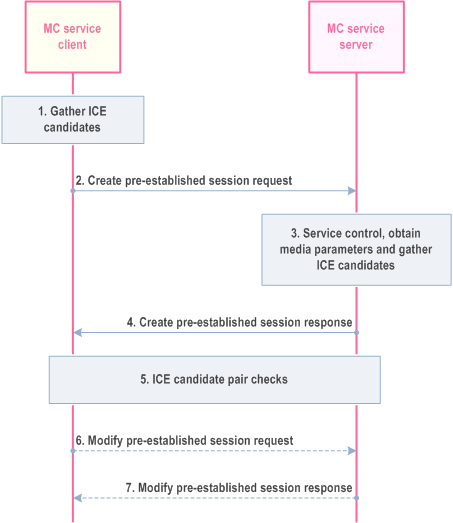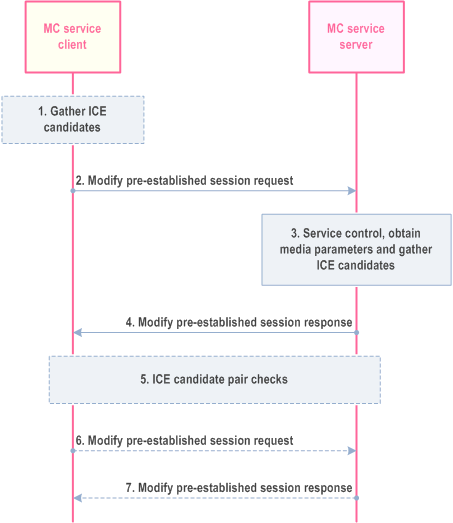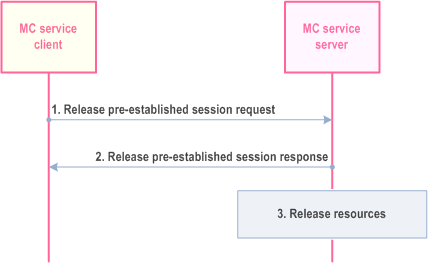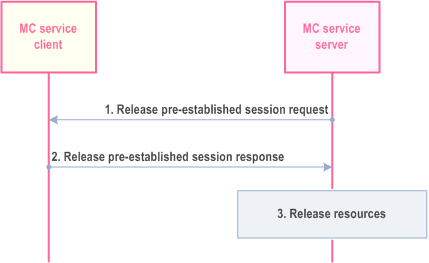Content for TS 23.280 Word version: 19.2.0
1…
5…
5.2.8…
6
7…
7.3.2
7.4…
7.4.3…
7.5…
8…
9…
9.2.2…
9.2.2.2…
9.3…
10…
10.1.2…
10.1.3…
10.1.4.3…
10.1.4.5…
10.1.5…
10.1.6…
10.2…
10.2.3…
10.2.4.2…
10.2.4.3…
10.2.5…
10.2.7…
10.3…
10.6…
10.7…
10.7.3…
10.7.3.4…
10.7.3.7…
10.7.3.7.3
10.7.3.8…
10.7.3.10…
10.8…
10.8.4…
10.8.5…
10.9…
10.9.3…
10.9.3.5…
10.9.3.8…
10.9.3.9…
10.9.3.9.3…
10.9.3.9.4…
10.9.3.10…
10.9.3.10.4…
10.9.3.10.6…
10.10…
10.10.1.2.3…
10.10.2…
10.10.3…
10.10.3.3…
10.10.3.4…
10.11…
10.11.5…
10.12…
10.13…
10.13.3…
10.13.7…
10.13.10…
10.14…
10.15…
10.15.3…
10.15.3.3…
10.15.3.4…
10.16…
10.17…
10.17.3…
10.17.5…
11…
11.3…
11.5…
11.5.2…
11.5.3…
11.5.3.3.2A…
11.5.4…
A…
B…
C…
10.3 Pre-established session (on-network)
10.3.1 General
10.3.2 Procedures
10.3.2.1 General
10.3.2.2 Pre-established session establishment
10.3.2.3 Pre-established session modification
10.3.2.4 Pre-established session release
10.4 Simultaneous session (on-network)
10.4.1 General
10.5 Use of UE-to-network relay
10.5.1 UE-to-network relay service authorization
10.5.2 UE-to-network relay MC service
...
...
10.3 Pre-established session (on-network) p. 121
10.3.1 General p. 121
A pre-established session is a session established between an MC service client and the MC service server, on a per MC service basis, to exchange necessary media parameters needed for the definition of media bearers, allowing a faster set-up of MC service calls/sessions.
After a pre-established session is established, a media bearer carrying the media and media control messages is always active. The MC service client establishes one or more pre-established sessions to an MC service server after SIP registration, and prior to initiating any MC service related procedures (e.g. calls, sessions) to other MC service users. When establishing a pre-established session, the MC service client negotiates the media parameters, including establishing IP addresses and ports using interactive connectivity establishment (ICE) as specified in RFC 5245, which later can be used in MC service calls/sessions. This avoids the need to negotiate media parameters (including evaluating ICE candidates) and reserving bearer resources during the MC service call/session establishment that results in delayed MC service call/session establishment.
The use of pre-established session on the origination side is completely compatible with the use of on demand session on the termination side. The use of pre-established session on the termination side is completely compatible with the use of on demand session on the origination side.
The pre-established session may be modified by the MC service client and the MC service server using the SIP procedures for session modification.
The pre-established session may be released by the MC service client and the MC service server using the SIP procedures for terminating a SIP session.
10.3.2 Procedures p. 121
10.3.2.1 General p. 121
The pre-established session can be established after MC service authorization for the user (see TS 23.379).
The pre-established session is a session establishment procedure between the MC service client and the MC service server to exchange necessary media parameters needed for the definition of the media bearers. After the pre-established session is established, the media bearer carrying the floor control messages is always active. Additionally, the MC service client is able to activate the media bearer carrying the voice whenever needed:
- immediately after the pre-established session procedure; or
- using SIP signalling when an MC service call is initiated.
10.3.2.2 Pre-established session establishment p. 121
The pre-established session is a session between the MC service client and the MC service server in the MC system, and which may utilise other functional entities (e.g. a media distribution function, as defined in subclause 7.4.2.3.5, for means of obtaining media parameters and gathering ICE candidates). Figure 10.3.2.2-1 represents the pre-established session establishment flow.

Step 1.
The MC service client within the MC service UE gathers ICE candidates.
Step 2.
The MC service client within the MC service UE sends a request to the MC service server to create a pre-established session.
Step 3.
MC service server performs necessary service control, obtains media parameters (e.g. by means of interacting with a media distribution function of the MC service server) and gathers ICE candidates.
Step 4.
MC service server sends a create pre-establish session response to the MC service client within the MC service UE.
Step 5.
ICE candidate pair checks take place e.g. between the MC service client within the MC service UE and a media distribution function of the MC service server.
Step 6.
If necessary the MC service client within the MC service UE sends a modify pre-established session request to the MC service server to update the ICE candidate pair for the pre-established session.
Step 7.
The MC service server sends a modify pre-established session response accepting the ICE candidate pair update.
The media sessions consist of at least an active media session carrying the media and media control messages and an inactive media session for the media.
10.3.2.3 Pre-established session modification p. 122
Figure 10.3.2.3-1 represents the pre-established session modification flow.

Step 1.
The MC service client within the MC service UE gathers ICE candidates, if necessary (e.g. depending on the information that needs to be updated).
Step 2.
The MC service client within the MC service UE sends a request to the MC service server to modify a pre-established session.
Step 3.
MC service server performs necessary service control, obtains any necessary media parameters (e.g. by means of interacting with a media distribution function of the MC service server) and gathers necessary ICE candidates.
Step 4.
MC service server sends a modify pre-establish session response to the MC service client within the MC service UE.
Step 5.
If necessary, ICE candidate pair checks take place e.g. between the MC service client within the MC service UE and a media distribution function of the MC service server.
Step 6.
If necessary the MC service client within the MC service UE sends a modify pre-established session request to the MC service server to update the ICE candidate pair for the pre-established session.
Step 7.
The MC service server sends a modify pre-established session response accepting the ICE candidate pair update.
10.3.2.4 Pre-established session release p. 124
Figure 10.3.2.4-1 represents the MC service client within the MC service UE initiated pre-established session release flow and Figure 10.3.2.4-2 represents the MC service server initiated pre-established session release flow.

Step 1.
The MC service client within the MC service UE sends a request to the MC service server to release a pre-established session.
Step 2.
The MC service server sends a release pre-establish session response to the MC service client within the MC service UE.
Step 3.
The MC service server releases all resources for the pre-established session.

Step 1.
The MC service server sends a request to the MC service client within the MC service UE to release a pre-established session.
Step 2.
The MC service client within the MC service UE sends a release pre-establish session response to the MC service server.
Step 3.
The MC service server releases all resources for the pre-established session.
10.4 Simultaneous session (on-network) p. 125
10.4.1 General p. 125
A simultaneous session is functionality whereby the MC service client can receive the media from multiple MC service calls/sessions over the same SIP session and media bearer(s) between the MC service client and the MC service server.
10.5 Use of UE-to-network relay p. 125
10.5.1 UE-to-network relay service authorization p. 125
The MC service shall support the capability for UE-to-network relay to restrict the relayed group communication on a per group basis.
To meet the above requirement, ProSe (as specified in TS 23.303) can be used with an appropriate relay service code as per the following:
-
To restrict connection from only the membership of allowed MC service groups, UE-to-network relay UE is provisioned with relay service code(s) associated with allowed MC service group(s). The UE-to-network relay performs the access control as follows:
- The UE broadcasts which MC service group(s) is/are authorized to connect to the network over this UE-to-network relay by including the related relay service code(s) in the UE-to-Network Relay Discovery Announcement message (as specified in TS 23.303); or
- The UE determines whether to respond to a remote UE's broadcasting message by checking if the relay service code carried in the UE-to-Network Relay Discovery Solicitation message is within the list of allowed relay service codes.
-
To find a permitted UE-to-network relay, a remote UE is provisioned with the relay service code(s) associated MC service group(s) which the MC service user belongs to. The remote UE performs the UE-to-network relay selection as follows:
- The remote UE determines if it is allowed to connect to a particular UE-to-network relay by checking whether the relay service code(s) associated with its MC service group(s) is/are carried in UE-to-Network Relay Discovery Announcement message (as specified in TS 23.303; or
- The remote UE includes the relay service code(s) associated with its MC service group(s) in Network Relay Discovery Solicitation message (as specified in TS 23.303).
10.5.2 UE-to-network relay MC service p. 125
The ProSe UE-to-network relay provides a purely layer 3 IP data routing service, when the remote UE loses the coverage of cellular network and the MC service user on the remote UE requires to access the MC service via a ProSe UE-to-network relay.
The application layer signalling for the MC service user on a remote UE are identical to the application layer signalling for the MC service user on an on-network UE.